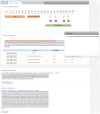Cyanobacterial KnowledgeBase (CKB), a Compendium of Cyanobacterial Genomes and Proteomes
- PMID: 26305368
- PMCID: PMC4549288
- DOI: 10.1371/journal.pone.0136262
Cyanobacterial KnowledgeBase (CKB), a Compendium of Cyanobacterial Genomes and Proteomes
Abstract
Cyanobacterial KnowledgeBase (CKB) is a free access database that contains the genomic and proteomic information of 74 fully sequenced cyanobacterial genomes belonging to seven orders. The database also contains tools for sequence analysis. The Species report and the gene report provide details about each species and gene (including sequence features and gene ontology annotations) respectively. The database also includes cyanoBLAST, an advanced tool that facilitates comparative analysis, among cyanobacterial genomes and genomes of E. coli (prokaryote) and Arabidopsis (eukaryote). The database is developed and maintained by the Sub-Distributed Informatics Centre (sponsored by the Department of Biotechnology, Govt. of India) of the National Facility for Marine Cyanobacteria, a facility dedicated to marine cyanobacterial research. CKB is freely available at http://nfmc.res.in/ckb/index.html.
Conflict of interest statement
Figures






Similar articles
-
CyanoBase: a large-scale update on its 20th anniversary.Nucleic Acids Res. 2017 Jan 4;45(D1):D551-D554. doi: 10.1093/nar/gkw1131. Epub 2016 Nov 29. Nucleic Acids Res. 2017. PMID: 27899668 Free PMC article.
-
cTFbase: a database for comparative genomics of transcription factors in cyanobacteria.BMC Genomics. 2007 Apr 18;8:104. doi: 10.1186/1471-2164-8-104. BMC Genomics. 2007. PMID: 17439663 Free PMC article.
-
CyanoOmicsDB: an integrated omics database for functional genomic analysis of cyanobacteria.Nucleic Acids Res. 2022 Jan 7;50(D1):D758-D764. doi: 10.1093/nar/gkab891. Nucleic Acids Res. 2022. PMID: 34614159 Free PMC article.
-
Advances in genomics, transcriptomics and proteomics of toxin-producing cyanobacteria.Environ Microbiol Rep. 2016 Feb;8(1):3-13. doi: 10.1111/1758-2229.12366. Epub 2016 Jan 22. Environ Microbiol Rep. 2016. PMID: 26663762 Review.
-
MalaCards: an amalgamated human disease compendium with diverse clinical and genetic annotation and structured search.Nucleic Acids Res. 2017 Jan 4;45(D1):D877-D887. doi: 10.1093/nar/gkw1012. Epub 2016 Nov 28. Nucleic Acids Res. 2017. PMID: 27899610 Free PMC article. Review.
Cited by
-
Transdisciplinary approaches for the study of cyanobacteria and cyanotoxins.Curr Res Microb Sci. 2024 Oct 11;7:100289. doi: 10.1016/j.crmicr.2024.100289. eCollection 2024. Curr Res Microb Sci. 2024. PMID: 39469049 Free PMC article.
-
Diversity of Glutathione S-Transferases (GSTs) in Cyanobacteria with Reference to Their Structures, Substrate Recognition and Catalytic Functions.Microorganisms. 2020 May 11;8(5):712. doi: 10.3390/microorganisms8050712. Microorganisms. 2020. PMID: 32403363 Free PMC article.
-
Omics for Bioprospecting and Drug Discovery from Bacteria and Microalgae.Antibiotics (Basel). 2020 May 4;9(5):229. doi: 10.3390/antibiotics9050229. Antibiotics (Basel). 2020. PMID: 32375367 Free PMC article. Review.
-
Bacterial Diversity and Nitrogen Utilization Strategies in the Upper Layer of the Northwestern Pacific Ocean.Front Microbiol. 2018 Apr 25;9:797. doi: 10.3389/fmicb.2018.00797. eCollection 2018. Front Microbiol. 2018. PMID: 29922238 Free PMC article.
References
-
- Bryant DA (1994) The Molecular Biology of Cyanobacteria. Dordrecht: Kluwer Academic Publishers; 613–639. 10.1007/978-94-011-0227-8 - DOI
-
- Whitton BA, Potts M (2002) The Ecology of Cyanobacteria, Their Diversity in Time and Space. Kluwer Academic Publisher; Dordrecht: 563–589. 10.1007/0-306-46855-7 - DOI
-
- Tan LT (2007) Bioactive natural products from marine cyanobacteria for drug discovery. Phytochemistry 68: 954–979. - PubMed
-
- Burja AM, Banaigs B, Abou-Mansour E, Grant Burgess J, Phillip C. Wright (2001) Marine cyanobacteria-a prolific source of natural products. Tetrahedron 57:9347–9377. 10.1016/S0040-4020(01)00931-0 - DOI
Publication types
MeSH terms
Substances
LinkOut - more resources
Full Text Sources
Other Literature Sources
Molecular Biology Databases
Research Materials
Miscellaneous

